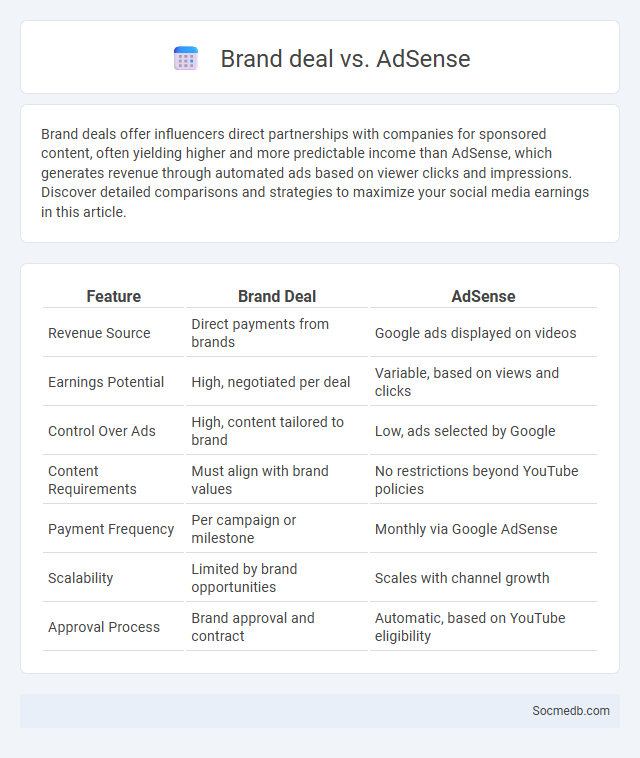
Photo illustration: Brand deal vs AdSense
Brand deals offer influencers direct partnerships with companies for sponsored content, often yielding higher and more predictable income than AdSense, which generates revenue through automated ads based on viewer clicks and impressions. Discover detailed comparisons and strategies to maximize your social media earnings in this article.
Table of Comparison
| Feature | Brand Deal | AdSense |
|---|---|---|
| Revenue Source | Direct payments from brands | Google ads displayed on videos |
| Earnings Potential | High, negotiated per deal | Variable, based on views and clicks |
| Control Over Ads | High, content tailored to brand | Low, ads selected by Google |
| Content Requirements | Must align with brand values | No restrictions beyond YouTube policies |
| Payment Frequency | Per campaign or milestone | Monthly via Google AdSense |
| Scalability | Limited by brand opportunities | Scales with channel growth |
| Approval Process | Brand approval and contract | Automatic, based on YouTube eligibility |
Introduction to Monetization Models
Monetization models on social media encompass various strategies such as advertising, subscription services, and sponsored content to generate revenue from user engagement. Platforms like YouTube and Instagram enable creators to earn through ad placements, brand partnerships, and fan support mechanisms like memberships or tips. Understanding these models helps you leverage your content effectively to maximize income and growth opportunities.
What is a Brand Deal?
A brand deal is a contractual partnership between a social media influencer and a company where the influencer promotes the company's products or services to their audience. These deals often involve sponsored posts, product placements, or dedicated campaigns to enhance brand visibility and drive sales. Successful brand deals leverage the influencer's reach and engagement metrics to create authentic, targeted marketing content.
Understanding AdSense Revenue
Understanding AdSense revenue involves analyzing your website's traffic sources, user engagement, and the types of ads displayed on your social media platforms. Effective targeting and relevant content increase ad clicks, boosting overall earnings from Google AdSense. Optimizing your social media strategy directly impacts your revenue potential by maximizing impressions and click-through rates.
Comparing Brand Deals and AdSense
Brand deals offer customized partnerships where You collaborate directly with companies to promote products or services, often yielding higher, fixed payments based on campaign scope. AdSense generates revenue through automated ads displayed on Your social media content, providing passive income that fluctuates with traffic and ad engagement. Both monetization methods leverage Your audience but differ significantly in revenue control, predictability, and partnership depth.
Pros and Cons of Brand Deals
Brand deals on social media offer influencers significant financial rewards and increased exposure, enabling brand alignment with target audiences for higher engagement rates. However, these partnerships may lead to authenticity concerns, risking followers' trust if content appears overly commercialized or disingenuous. Balancing sponsored content with organic posts is essential to maintain audience loyalty and optimize brand credibility.
Advantages and Limitations of AdSense
AdSense offers a powerful monetization opportunity for social media creators by enabling targeted ad revenue based on content and audience demographics, enhancing your income potential through relevant ads. Limitations include strict policy compliance, which can lead to account suspension if violated, and variable income due to fluctuating ad demand and user engagement. Understanding these factors helps you optimize content strategy while maintaining adherence to AdSense guidelines for sustainable earnings.
Brand Deal Negotiation Strategies
Mastering brand deal negotiation strategies on social media involves clearly defining your value proposition and understanding the target brand's audience and goals. You can leverage your engagement metrics and content quality to justify higher compensation and favorable contract terms. Employing transparent communication and setting realistic expectations increases the likelihood of forming successful and long-term partnerships.
Earning Potential: Brand Deals vs AdSense
Social media influencers often maximize their earning potential through brand deals, which typically offer higher payouts compared to AdSense revenue generated from video views or ads. Brand collaborations can provide fixed fees, performance bonuses, and long-term partnerships, making them more lucrative than the variable and often lower income from AdSense. Influence marketing platforms and analytics tools highlight that niche engagement rates directly impact brand deal opportunities, outweighing general ad revenue metrics.
Choosing the Right Monetization Approach
Selecting the right social media monetization approach depends on your content type, audience demographics, and engagement levels. You can leverage methods such as sponsored posts, affiliate marketing, paid subscriptions, or direct product sales to maximize revenue. Understanding platform-specific algorithms and analytics helps tailor your strategy for optimal financial growth.
Conclusion: Maximizing Content Creator Income
Maximizing content creator income on social media requires strategic use of diverse revenue streams such as sponsorships, affiliate marketing, and direct fan support through platforms like Patreon or YouTube memberships. Your engagement rates and audience demographics directly influence brand partnerships and monetization opportunities. Consistently analyzing performance metrics and adapting content to audience preferences ensures sustainable growth and increased earnings.
 socmedb.com
socmedb.com